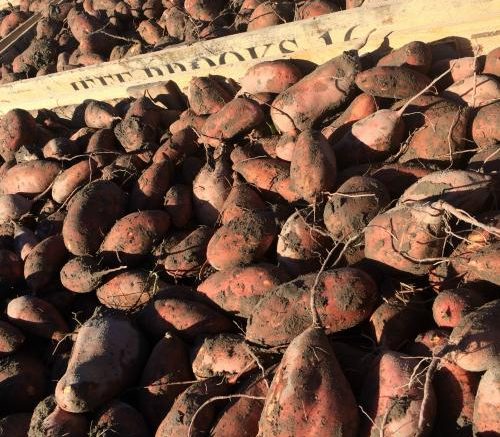It’s a race against time to get North Carolina sweet potatoes dug.
Hurricane Matthew dropped up to 15 inches of rain in some parts of the state in one day. Sweet potatoes are ideally planted on sandy soils that drain well. However, two weeks ago many of the same areas received 10 inches of rain. The soil didn’t have time to dry out before Matthew came to town.
Fields near creeks, streams, and rivers were flooded as water flowed over the banks. Low-lying areas in fields had water sitting. Soils that don’t drain well were saturated. Water running through fields washed soil away from sweet potatoes.

If the roots (yes, sweet potatoes are edible roots) sit in saturated soil, they will rot. However, getting them dug is a dirty, time-consuming task.
The storm left Saturday night, but it was Wednesday before we were able to get back in the field.
Trucks that normally drive right across the field had to be pulled by tractors. At one point, they had two tractors pulling a truck and another tractor pushing it from behind.

Sweet potatoes that would normally be flipped on top of the ground by the plow and easily seen by workers are covered in dirt.
As they harvest, workers are also having to check for rot. Roots that sat in water could rot and one rotten sweet potato in a bin could damage its neighbors. Bins will have to be checked often while in storage for signs of rot.

Power outages have also caused challenges for farmers. Sweet potatoes are stored in temperature-controlled buildings, and when the power goes out there is no air conditioning to keep the crop cool. Farmers can open the doors and vents to let cool air inside since the temperature has dropped, but I’m not sure how long that can last before the roots in storage start to show the effects. We were lucky – we didn’t lose power. There are still areas without power, six days after the storm.
Roads are another concern. The water covered roads, washed out roads, or caused sinkholes to form. It is so bad that parts of Interstate 95, a major interstate going through North Carolina from Virginia to South Carolina, remain closed. It could take months to repair all the roads impacted, which could make getting to the field difficult.
North Carolina produces over 50% of the United States sweet potato crop. Approximately half of this year’s crop was still in the field when Matthew came to visit. Some of those roots are still under water. Some will never be dug.
Many people in our state and in states along the East Coast have been affected, and its true impact won’t be known for months. How were you affected?
Originally posted at Agriculture.com


